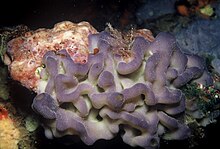Oscarella lobularis
| Oscarella lobularis | |
|---|---|

| |
| Scientific classification | |
| Domain: | Eukaryota |
| Kingdom: | Animalia |
| Phylum: | Porifera |
| Class: | Homoscleromorpha |
| Order: | Homosclerophorida |
| Family: | Oscarellidae |
| Genus: | Oscarella |
| Species: | O. lobularis
|
| Binomial name | |
| Oscarella lobularis | |
| Synonyms[1] | |
|
List
| |
Oscarella lobularis is a species of sponge in the order Homosclerophorida. It is native to the northeastern Atlantic Ocean and the Mediterranean Sea, where it forms encrusting colonies on rocks and other hard surfaces.
Description
Oscarella lobularis is an encrusting sponge that forms a thick layer of soft, gelatinous consistency with a velvety surface, on rocks, stones and large seaweeds.
Ecology
Like other sponges, Oscarella lobularis is a filter feeder. Water is drawn into the interior of the sponge through the ostia, the bacteria and organic particles on which the sponge feeds are filtered out, and the surplus water is expelling through the osculi.[3] This sponge is a hermaphrodite; ciliated larvae known as parenchymella larvae are liberated into the water and soon settle on the substrate and undergo metamorphosis into the adult form.[2][3]
This sponge can reproduce asexually. Colonies growing under overhangs can develop elongations that become shaped like tear-drops, dangle on threads of tissue and eventually detach, landing on the seabed below and growing into new colonies; the sponge has also been observed to develop bubble-like buds on its external surface which become detached and, being buoyant, are dispersed by currents in the water column and rapidly grow into new colonies.[4]
Research
Oscarella lobularis has been used as a model organism for the study of evolutionary biology and developmental biology, being particularly suitable because of its easy availability, its simple histology and cell composition, its robust epithelial structures and because it lacks a skeleton.[5]
Researchers have studied the different colour morphs of this sponge which sometimes grow alongside each other. There appears to be a cryptic complex and two species that had been synonymised in 1877 have been redescribed as O. lobularis (violet in colour) and
References
- ^ a b van Soest, Rob W.M. (2018). "Oscarella lobularis (Schmidt, 1862)". WoRMS. World Register of Marine Species. Retrieved 30 September 2018.
- ^ a b Richards, S. (3 July 2008). "A sponge (Oscarella lobularis)". MarLIN. Retrieved 30 September 2018.
- ^ ISBN 978-81-315-0104-7.)
{{cite book}}: CS1 maint: multiple names: authors list (link - ISBN 978-0-12-387791-8.
- S2CID 205469182.
- ISBN 978-0-12-387791-8.
External links
- Photos of Oscarella lobularis on Sealife Collection
